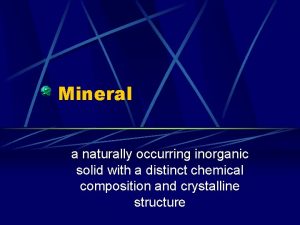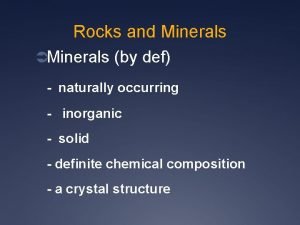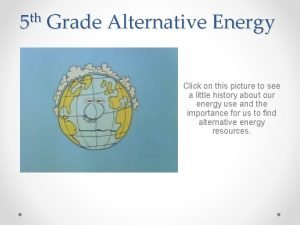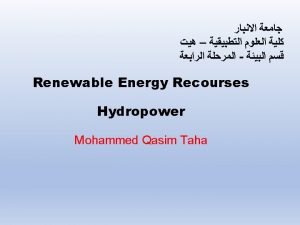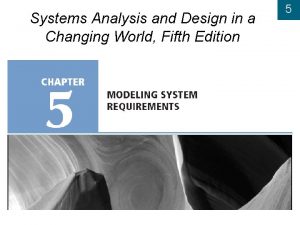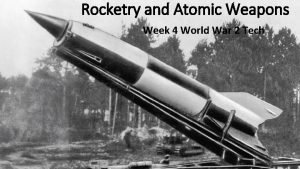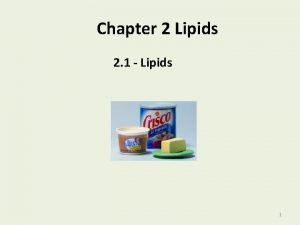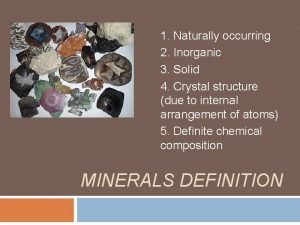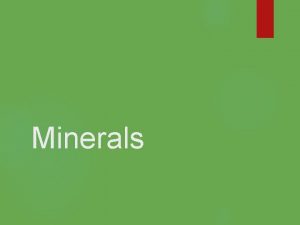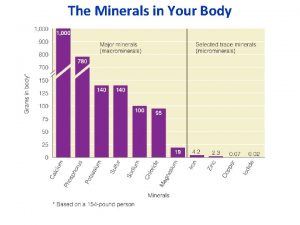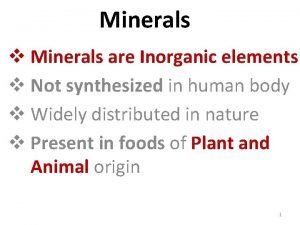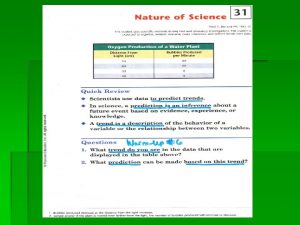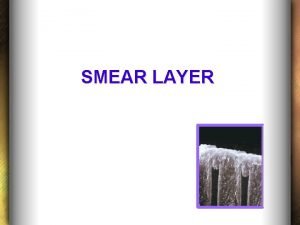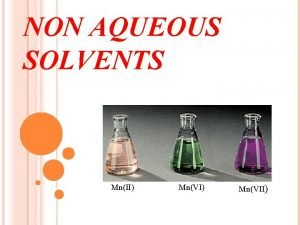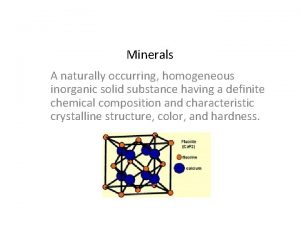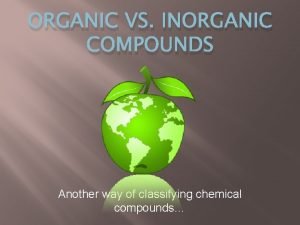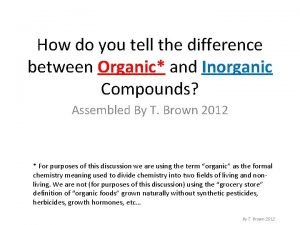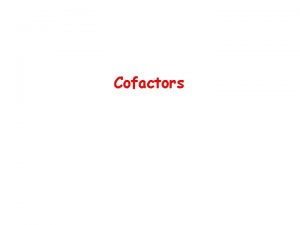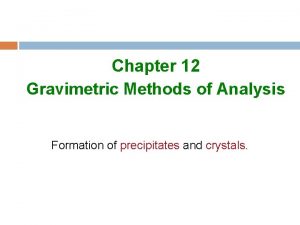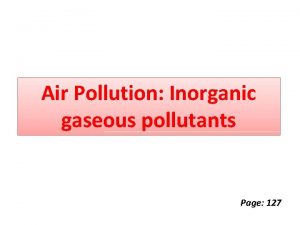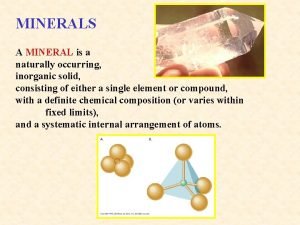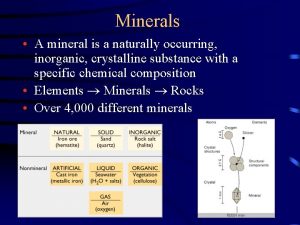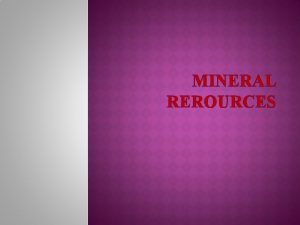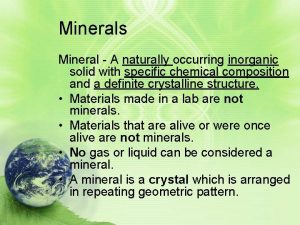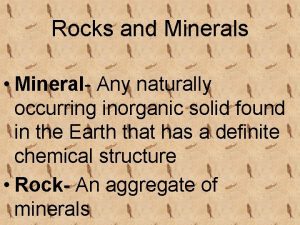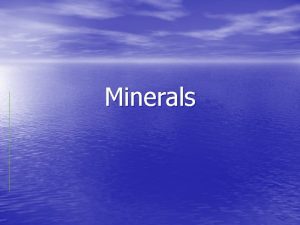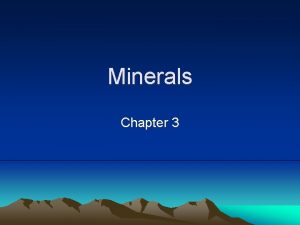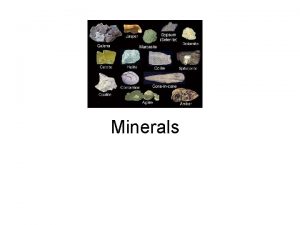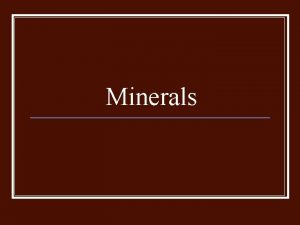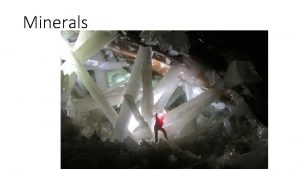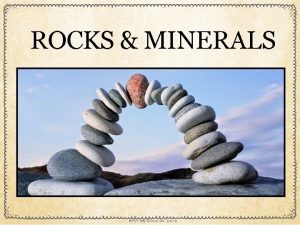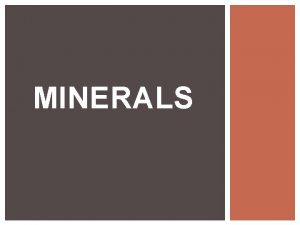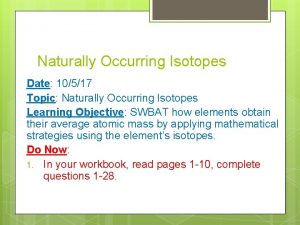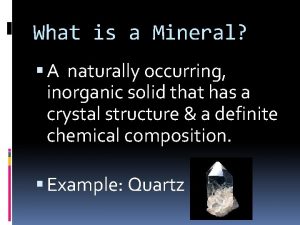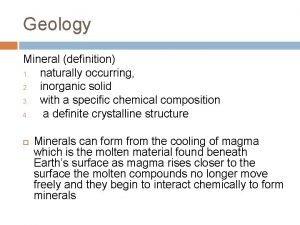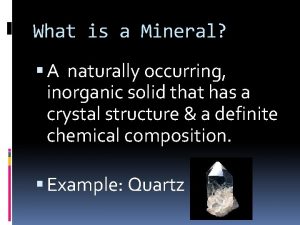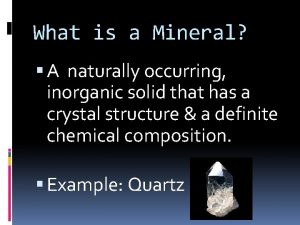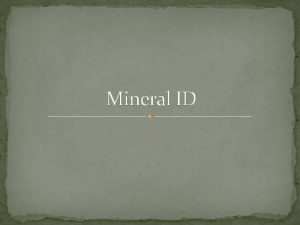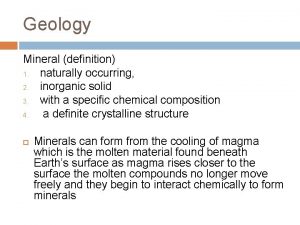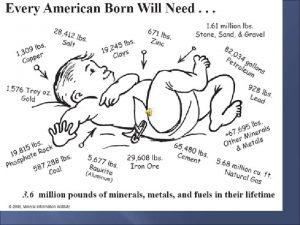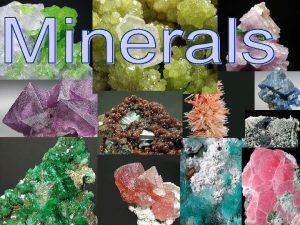Minerals What is a Mineral Naturally occurring Inorganic































- Slides: 31

Minerals

What is a Mineral? �Naturally occurring �Inorganic �Solid �Crystal structure �Definite chemical composition

How do we ID Minerals? � Color � streak � Luster � Density � Hardness � Crystal forms � Cleavage � Special and fracture properties (not all minerals have these)

Color

Luster

Streak

Density

Hardness

Crystal Form

Cleavage and Fracture



Special Properties Smell Taste Fluorescents

How minerals form �From magma and lava �From solution �Evaporation �Hot water solution

How Minerals Form In general, minerals form in two ways: • By crystallization of magma & lava • By crystallization of materials dissolved in water.

Minerals From Magma & Lava Minerals form as hot magma cools inside the crust or when lava hardens on the surface.

Crystallization is the process by which atoms are arranged to form a material with a crystal structure.

A geode is a rounded hollow rock that is often lined with mineral crystals.

The size of the crystal depends upon several factors: • The rate (speed) at which the molten material cools. • The amount of gas in the molten material. • The chemical composition of the molten material (or what elements/chemicals make up the molten rock.

Magma deep inside the earth takes thousands of years to cool. Slow cooling results in large crystals.

Magma close to the earth’s surface or lava that cools on the surface will cool more quickly.

Rapid cooling results in small crystals…. sometimes microscopic.

Minerals From Solutions Elements/Compounds that form minerals may sometimes be dissolved in water to form a solution.

When elements/compounds that are dissolved in water leave a solution, crystallization can occur.

Minerals Formed by Evaporation Some minerals form when solutions evaporate. Large deposits of halite in the USA formed this way.

Minerals From Hot Water Solutions Underground, magma can heat water to high temperatures. Elements/Compounds may become dissolved in this hot solution.

When the water solution cools the elements and compounds crystallize as minerals.

Pure metals that crystallize from hot water solutions underground often form veins.

A vein is a narrow channel or slab of a mineral that is different from the surrounding rock.

Uses of minerals � Gemstones � Metals � Food � Medicines � Fertilizers � Building materials

How do we get minerals so we can use them? � First we have to prospect for them � Next we have to mine them � 3 types of mines �Strip �Open pit �Shaft � Next comes processing � Smelting- separates useful metal from other elements � Further processing to remove impurities
 A naturally occurring inorganic solid
A naturally occurring inorganic solid Minerals def
Minerals def Naturally occurring areas of hydrothermal resources
Naturally occurring areas of hydrothermal resources Naturally occurring areas of hydrothermal resources
Naturally occurring areas of hydrothermal resources Naturally occurring antibodies
Naturally occurring antibodies Largest naturally occurring element
Largest naturally occurring element Is a naturally occurring association among specific things
Is a naturally occurring association among specific things Heaviest naturally occurring element
Heaviest naturally occurring element Glyceryl tripalmitate saponification
Glyceryl tripalmitate saponification Geothermal energy advantages and disadvantages
Geothermal energy advantages and disadvantages Inorganic mineral definition
Inorganic mineral definition Inorganic mineral definition
Inorganic mineral definition Enzim
Enzim Iron deficiency anemia smear
Iron deficiency anemia smear Find the probability of z occurring in the indicated region
Find the probability of z occurring in the indicated region What process is occurring
What process is occurring Find the probability of z occurring in the indicated region
Find the probability of z occurring in the indicated region Smear layer definicion
Smear layer definicion Solvent in chemical reactions
Solvent in chemical reactions Homogeneous inorganic substances
Homogeneous inorganic substances Organic vs inorganic compounds
Organic vs inorganic compounds Organic vs inorganic compounds
Organic vs inorganic compounds Organic and inorganic cofactors
Organic and inorganic cofactors Inorganic chemistry vs organic chemistry
Inorganic chemistry vs organic chemistry Inorganic pollution
Inorganic pollution Organic vs inorganic
Organic vs inorganic Organic and inorganic nutrients
Organic and inorganic nutrients Inorganic content of calculus
Inorganic content of calculus Mechanical entrapment coprecipitation
Mechanical entrapment coprecipitation Inorganic gaseous pollutants of air
Inorganic gaseous pollutants of air Organic molecules vs inorganic molecules
Organic molecules vs inorganic molecules Inorganic nomenclature
Inorganic nomenclature
